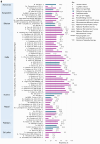Preconception malnutrition among women and girls in south Asia: prevalence, determinants, and association with pregnancy and birth outcomes
- PMID: 40421123
- PMCID: PMC12105519
- DOI: 10.1016/j.lansea.2025.100573
Preconception malnutrition among women and girls in south Asia: prevalence, determinants, and association with pregnancy and birth outcomes
Abstract
This review highlights the growing double burden of malnutrition among women of reproductive age in South Asia. Using nationally-representative survey data, we highlight that the prevalence of overweight now exceeds that of underweight, while anaemia remains persistently high despite intervention efforts. Underweight and anaemia are more common among unmarried women, whereas overweight is more prevalent among parous women, underscoring the need for life-stage-specific preconception nutrition programs. In our systematic review, micronutrient deficiencies vary widely between and within countries, reflecting regional disparities in nutritional status and inconsistencies in diagnostic methods. Associations of preconception underweight, overweight, anaemia and micronutrient deficiencies with health, nutrition, socio-demographic, and WASH indicators are mixed, emphasising the need for tailored, context-specific interventions. The lack of longitudinal studies limits our understanding of associations between preconception nutritional status and subsequent birth outcomes, underscoring the need for comprehensive, longitudinal studies across South Asia to inform and monitor targeted nutrition programs.
Keywords: Adolescent; Anaemia; Demographic and health survey; Micronutrient; Nutrition; Overweight; Preconception; Pregnancy planning; Review; Underweight.
© 2025 The Author(s).
Conflict of interest statement
Co-authors VS and ZM are employees of UNICEF Regional Office for south Asia (RoSA) which funded this study. Other authors have no conflicts of interest. DS is supported by the National Institute for Health and Care Research (NIHR) through an NIHR Advanced Fellowship (NIHR302955) and the NIHR Southampton Biomedical Research Centre (NIHR203319). The authors declare no other conflicts of interest.
Figures






Similar articles
-
Core state preconception health indicators - pregnancy risk assessment monitoring system and behavioral risk factor surveillance system, 2009.MMWR Surveill Summ. 2014 Apr 25;63(3):1-62. MMWR Surveill Summ. 2014. PMID: 24759729
-
Effects of preconception nutrition interventions on pregnancy and birth outcomes in South Asia: a systematic review.Lancet Reg Health Southeast Asia. 2025 Apr 24;36:100580. doi: 10.1016/j.lansea.2025.100580. eCollection 2025 May. Lancet Reg Health Southeast Asia. 2025. PMID: 40421124 Free PMC article. Review.
-
Nutrition status of nulliparous married women (15-24 years) in South Asia: trends, predictors, and program implications.Front Nutr. 2024 Nov 18;11:1445314. doi: 10.3389/fnut.2024.1445314. eCollection 2024. Front Nutr. 2024. PMID: 39624688 Free PMC article.
-
Double malnutrition and associated factors in a middle-aged and older, rural South African population.BMC Nutr. 2024 Jun 10;10(1):84. doi: 10.1186/s40795-024-00890-6. BMC Nutr. 2024. PMID: 38858730 Free PMC article.
-
Prevalence, determinants, intervention strategies and current gaps in addressing childhood malnutrition in Vietnam: a systematic review.BMC Public Health. 2024 Apr 4;24(1):960. doi: 10.1186/s12889-024-18419-8. BMC Public Health. 2024. PMID: 38575928 Free PMC article.
References
-
- UNICEF . 2023. Undernourished and overlooked: a global nutrition crisis in adolescent girls and women. New York.
-
- Ferdausi F., Al-Zubayer M.A., Keramat S.A., Ahammed B. Prevalence and associated factors of underweight and overweight/obesity among reproductive-aged women: a pooled analysis of data from South Asian countries (Bangladesh, Maldives, Nepal and Pakistan) Diabetes Metab Syndr. 2022;16 doi: 10.1016/j.dsx.2022.102428. - DOI - PubMed
-
- Stevens G.A., Beal T., Mbuya M.N.N., et al. Micronutrient deficiencies among preschool-aged children and women of reproductive age worldwide: a pooled analysis of individual-level data from population-representative surveys. Lancet Glob Health. 2022;10:e1590–e1599. doi: 10.1016/S2214-109X(22)00367-9. - DOI - PMC - PubMed
Publication types
LinkOut - more resources
Full Text Sources

